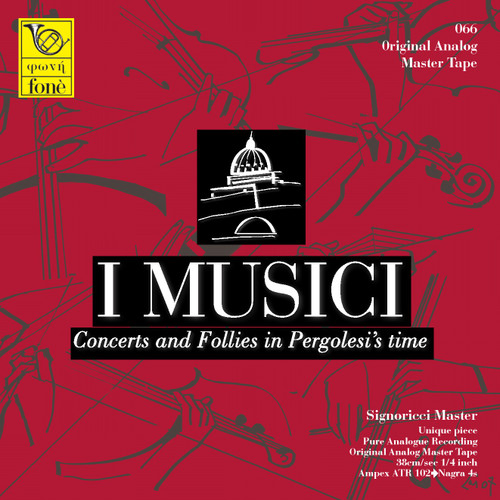Francesco Geminiani 1687-1762
1) Concerto Grosso n. 12 “La Madness” for strings and harpsichord 11' 22''
Giovanni Battista Pergolesi 1710 -1736
2.3.4) Concerto for violin, strings and continuous bass in B flat. major
Allegro 4' 35'' - Largo 3' 52'' - Allegro 3' 45''
Antonio Anselmi, violin
Antonio Vivaldi 1678 -1741
5.6.7) Concerto in G minor. for two cellos, strings, and continuo, RV 531
Allegro 3:15 - Largo 3:29 - Allegro 2:56
Vito Paternoster and Pietro Bosna, cellos
This album was recorded by Giulio Cesare Ricci at the "Casa di Spiritualità S. Teresa - Padri Carmelitani Scalzi" in Caprarola (VT) in August 2009.
I Musici is the most famous Italian chamber orchestra in the world.
With Concerti e Follie ai tempi di Pergolesi, they celebrated the 300th anniversary of the birth of the great composer Giovanni Battista Pergolesi, originally from the Marche region, by presenting rarely performed compositions, thus little known in the concert world.
The program begins with a tribute to Francesco Geminiani, a leading exponent of the Corellian school, along with Locatelli and Somis. The Concerto Grosso No. 12 from the Sonata, Op. 5 No. Arcangelo Corelli's "La follia" (The Madness), No. 12 for strings and harpsichord (theme and variations), evokes the brilliance of a captivating virtuosity that established him abroad, particularly in London, where the Italian maestro made his name by fostering the tradition of great violin performers with skills that pushed the boundaries of their time. Nor could we fail to mention Corelli, the undisputed master of the Baroque sonata, concerto, and violin, prefiguring, with his collections of instrumental music from 1681, the paths that would be fully realized in the following century. (...)
For the recording, Giulio Cesare Ricci used the legendary Neumann U47, U48, and M49 tube microphones and all his equipment: mic preamplifiers, line, and digital, Signoricci microphones and power cables.
Recorded in Stereo DSD on Pyramix using dCS A/D and D/A converters.
For this recording, Giulio Cesare Ricci also used a "field effect" recording technique, resulting in a natural sound, without the use of equalizers, sound expansion, or compression systems... all to allow listeners to experience the live effect on their home hi-fi system, as if they were present at the performances.
An album not to be missed!









